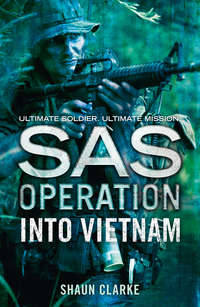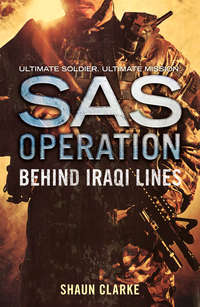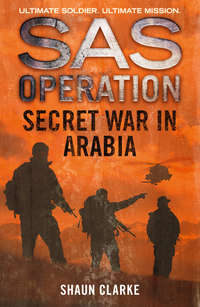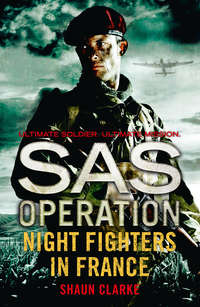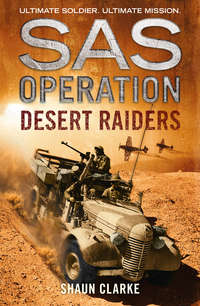
Полная версия
Into Vietnam
Even worse, the Australians often had to use the walkways when they were making their way back from a jungle patrol and being pursued by Indonesian troops. At such times the enemy could use the walkways as shooting galleries in which the Aussies made highly visible targets as they inched their way across.
This had been the experience of Shagger and Red during their last patrol before returning to Perth. Their patrol had been caught in the middle of an unusually high walkway, swaying over rapids 160 feet below, while the Indonesians unleashed small-arms fire on them, killing and wounding many men, until eventually they shot the rattan binding to pieces, making the walkway, with some unfortunates still on it, tear away from its moorings, sending the men still clinging to it screaming to their doom.
Shagger, though more experienced than Red, had suffered nightmares about that incident for weeks after the event, but Red, with his characteristic detachment, had only once expressed regret at the loss of his mates and then put the awful business behind him. And though, as he claimed, he had no head for heights, he had been very courageous on the walkways, often turning back to help more frightened men across, even in the face of enemy fire. He was a good man to have around.
‘The ground’s getting higher,’ Shagger said, having noticed that the scummy water was now only as high as his knees. ‘That means we’re heading towards the islet marked on the map. That’s our ambush position.’
‘You think we’ll get there before they do?’ Red asked.
‘Let us pray,’ Shagger replied.
As he waded the last few hundred yards to the islet, now visible as a mound of firm ground covered with seedlings and brown leaves, with a couple of palm trees in the middle, Shagger felt the exhaustion of the past five days falling upon him. Three Squadron SAS had been sent to New Guinea to deploy patrols through forward airfields by helicopter and light aircraft; to patrol and navigate through tropical jungle and mountain terrain; to practise communications and resupply; and to liaise with the indigenous people.
For the past five days, therefore, the SAS men had sweated in the tropical heat; hacked their way through seemingly impassable secondary jungle with machetes; climbed incredibly steep, tree-covered hills; waded across rivers flowing at torrential speeds; oared themselves along slower rivers on ‘gripper bar’ rafts made from logs and four stakes; slept in shallow, water-filled scrapes under inadequate ponchos in fiercely driving, tropical rainstorms; suffered the constant buzzing, whining and biting of mosquitoes and hornets; frozen as poisonous snakes slithered across their booted feet; lost enormous amounts of blood to leeches; had some hair-raising confrontations with head-hunting natives – and all while reconnoitring the land, noting points of strategic value, and either pursuing, or being pursued by, the enemy.
Now, on the last day, Shagger and Red, having been separated accidentally from the rest of their troop during a shoot-out with an enemy column, were making their way to the location originally chosen for their own troop as an ambush position, where they hoped to have a final victory and then get back to base and ultimately Australia. After their long, arduous hike through the swamp they were both exhausted.
‘I’m absolutely bloody shagged,’ Red said, gasping. ‘I can hardly move a muscle.’
‘We can take a rest in a minute,’ Shagger told him. ‘Here’s our home from home, mate. The ambush position.’
The islet was about fifty yards from the far edge of the swamp they had just crossed, almost directly facing a narrow track that snaked into the jungle, curving away out of sight. It was along that barely distinguishable track that the enemy would approach on their route across the swamp, but in the opposite direction as they searched for Shagger’s divided patrol, which had undoubtedly been sighted by one of their many reconnaissance helicopters.
Wading up to the islet, pushing aside the gigantic, bright-green palm leaves that floated on its miasmal surface, Shagger and Red finally found firm ground beneath them and were able to lay down their SLRs and shrug off their heavy bergens. Relieved of that weight, they clambered up on to the islet’s bed of brown leaves and seedlings, rolled on to their backs and gulped in lungfuls of air. Both men did a lot of deep breathing before talking again.
‘Either I’m gonna flake out,’ Red finally gasped, ‘or I’m gonna have a good chunder. I feel sick with exhaustion.’
‘You can’t sleep and you can’t chuck up,’ Shagger told him. ‘You can chunder when you get back to base and have a skinful of beer. You can sleep there as well. Right now, though, we have to dig in and set up, then spring our little surprise. Those dills, if they get here at all, will be here before last light, so we have to be ready.’
‘Just let me have some water’, Red replied, ‘and I’ll be back on the ball.’
‘Go on, mate. Then let’s get rid of these bloody leeches and prepare the ambush. We’ll win this one, Red.’
When they had quenched their thirst, surprising themselves by doing so without vomiting, they lit cigarettes, inhaled luxuriously for a few minutes, then proceeded to burn off, with their cigarettes, the leeches still clinging to their bruised and scarred skin. As they were both covered with fat, black leeches, all still sucking blood, this operation took several cigarettes. When they had got rid of the bloodsuckers they wiped their skins down with antiseptic cream and set about making a temporary hide.
The islet was an almost perfect circle hardly more than thirty feet in diameter. The thick trees soaring up from the carpet of seedlings and leaves were surrounded by a convenient mass of dense foliage over which the branches draped their gigantic palm leaves. As this natural camouflage would give good protection, Shagger chose this area for the location of the hide and he and Red then dug out two shallow lying-up positions, or LUPs, using the small spades clipped to their webbing.
This done, each man began to construct a simple shelter over his LUP by driving two V-shaped wooden uprights into the soft soil, placed about six feet apart. A length of nylon cord was tied between the uprights, then a waterproof poncho was draped over the cord with the long end facing the prevailing wind and the short, exposed end, facing the path at the far side of the swamp. The two corners of each end were jerked tight and held down with small wooden pegs and nylon cord. The LUP was then filled with a soft bed of leaves and seedlings, a sleeping-bag was rolled out on to it, and the triangular tent was carefully camouflaged with giant leaves and other foliage held down with fine netting.
Once the shelters had been completed, the hide blended in perfectly with the surrounding vegetation, making it practically invisible to anyone coming along the jungle track leading to the swamp.
‘If they come out of there,’ Shagger said with satisfaction, ‘they won’t have a prayer. Now let’s check our kit.’
The afternoon sun was still high in the sky when each man checked his SLR, removing the mud, twigs, leaves and even cobwebs that had got into it; oiling the bolt, trigger mechanism and other moving parts; then rewrapping it in its jungle-coloured camouflage material. Satisfied that the weapons were in working order, they ate a cold meal of tinned sardines, biscuits and water, battling every second to keep off the attacking insects. Knowing that the enemy trying to find them would attempt to cross the swamp before the sun had set – which meant that if they came at all, they would be coming along the track quite soon – they lay on their bellies in their LUPs, sprinkled more loose foliage over themselves as best they could, and laid the SLRs on the lip of their shallow scrapes, barrels facing the swamp. Then they waited.
‘It’s been a long five days,’ Shagger said.
‘Too bloody long,’ Red replied. ‘And made no better by the fact that we’re doing the whole thing on a shoestring. Piss-poor, if you ask me.’
Shagger grinned. ‘The lower ranks’ whinge. How do you, a no-hoper corporal, know this was done on a shoestring?’
‘Well, no RAAF support, for a start. Just that bloody Ansett-MAL Caribou that was completely unreliable…’
‘Serviceability problems,’ Shagger interjected, still grinning. ‘But the Trans Australian Airlines DC3s and the Crowley Airlines G13 choppers were reliable. They made up for the lack of RAAF support, didn’t they?’
‘You’re joking. Those fucking G13s had no winch and little lift capability. They were as useless as lead balloons.’
‘That’s true,’ Shagger murmured, recalling the cumbersome helicopters hovering over the canopy of the trees, whipping up dust and leaves, as they dropped supplies or lifted men out. He fell silent, never once removing his searching gaze from the darkening path that led from the jungle to the edge of the swamp. Then he said, ‘They were piss-poor for resups and lift-offs – that’s true enough. But the DC3s were OK.’
Red sighed loudly, as if short of breath. ‘That’s my whole point. This was supposed to be an important exercise, preparing us for ’Nam, and yet we didn’t even get RAAF support. Those bastards in Canberra are playing silly buggers and wasting our time.’
‘No,’ Shagger replied firmly. ‘We didn’t waste our time. They might have fucked up, but we’ve learnt an awful lot in these five days and I think it’ll stand us in good stead once we go in-country.’
‘Let’s hope so, Sarge.’
‘Anyway, it’s no good farting against thunder, so you might as well forget it. If we pull off this ambush we’ll have won, then it’s spine-bashing time. We can…’
Suddenly Shagger raised his right hand to silence Red. At first he thought he was mistaken, but then, when he listened more intently, he heard what he assumed was the distant snapping of twigs and large, hardened leaves as a body of men advanced along the jungle path, heading for the swamp.
Using a hand signal, Shagger indicated to Red that he should adapt the firing position. When Red had done so, Shagger signalled that they should aim their fire in opposite directions, forming a triangular arc that would put a line of bullets through the front and rear of the file of enemy troops when it extended into the swamp from its muddy edge at the end of the path.
As they lay there waiting, squinting along their rifle sights, their biggest problems were ignoring the sweat that dripped from their foreheads into their eyes, and the insects that whined and buzzed about them, driven into a feeding frenzy by the smell of the sweat. In short, the most difficult thing was remaining dead still to ensure that they were not detected by their quarry.
Luckily, just as both of them were thinking that they might be driven mad by the insects, the first of the enemy appeared around the bend in the darkening path. They were marching in the classic single-file formation, with one man out ahead on ‘point’ as the lead scout, covering an arc of fire immediately in front of the patrol, and the others strung out behind him, covering arcs to the left and right.
When all the members of the patrol had come into view around the bed in the path, with ‘Tail-end Charlie’ well behind the others, covering an arc of fire to the rear, Shagger counted a total of eight men: two four-man patrols combined. All of them were wearing olive-green, long-sleeved cotton shirts; matching trousers with a drawcord waist; soft jungle hats with a sweat-band around the forehead; and rubber-soled canvas boots. Like Shagger and Red, they were armed with 7.62mm L1A1 SLRs and had 9mm Browning High Power pistols and machetes strung from their waist belts.
In short, the ‘enemy’ was a patrol of Australian troops.
‘Got the buggers!’ Shagger whispered, then aimed at the head of the single file as Red was taking aim at its rear. When the last man had stepped into the water, Shagger and Red both opened fire with their SLRs.
Having switched to automatic they stitched lines of spurting water across the front and rear of the patrol. Shocked, but quickly realizing that they were boxed in, the men under attack bawled panicky, conflicting instructions at one another, then split into two groups. These started heading off in opposite directions: one directly towards the islet, the other away from it.
Instantly, Shagger and Red jumped up to lob American M26 hand-grenades, one out in front of the men wading away from the islet, the other in front of the men wading towards it. Both grenades exploded with a muffled roar that threw up spiralling columns of water and rotting vegetation which then rained back down on the fleeing soldiers. Turning back towards one another, the two groups hesitated, then tried to head back to the jungle. They had only managed a few steps when Shagger and Red riddled the shore with the awesome automatic fire of their combined SLRs, tearing the foliage to shreds and showering the fleeing troops with flying branches and dangerously sharp palm leaves.
When the ‘enemy’ bunched up again, hesitating, Shagger and Bannerman stopped firing.
‘Drop your weapons and put your hands in the air!’ Shagger bawled at them. ‘We’ll take that as surrender.’
The men in the water were silent for some time, glancing indecisively at one another; but eventually a sergeant, obviously the platoon leader, cried out: ‘Bloody hell!’ Then he dropped his SLR into the water and raised both hands. ‘Got us fair and square,’ he said to the rest of his men. ‘We’re all prisoners of war. So drop your weapons and put up your hands, you happy wankers. We’ve lost. Those bastards have won.’
‘Too right, we have,’ Shagger and Red said simultaneously, with big, cheesy grins.
They had other reasons for smiling. This was the final action in the month-long training exercise ‘Traiim Nau’, conducted by Australian troops in the jungles and swamps of New Guinea in the spring of 1966.
In June that year, after they had returned to their headquarters in Swanbourne, and enjoyed two weeks’ leave, the men of 3 Squadron SAS embarked by boat and plane from Perth to help set up a Forward Operating Base (FOB) in Phuoc Tuy province, Vietnam.
2
In a small, relatively barren room in ‘the Kremlin’, the Operations Planning and Intelligence section, at Bradbury Lines, Hereford, the Commanding Officer of D Squadron, SAS, Lieutenant-Colonel Patrick ‘Paddy’ Callaghan, was conducting a most unusual briefing – unusual because there were only two other men present: Sergeants Jimmy ‘Jimbo’ Ashman and Richard ‘Dead-eye Dick’ Parker.
Ashman was an old hand who had served with the Regiment since it was formed in North Africa in 1941, fought with it as recently as 1964, in Aden, and now, in his mid-forties, was being given his next-to-last active role before being transferred to the Training Wing as a member of the Directing Staff. Parker had previously fought with the SAS in Malaya and Borneo and alongside Ashman in Aden. Jimbo was one of the most experienced and popular men in the Regiment, while Dead-eye, as he was usually known, was one of the most admired and feared. By his own choice, he had very few friends.
Lieutenant-Colonel Callaghan knew them both well, particularly Jimbo, with whom he went back as far as 1941 when they had both taken part in the Regiment’s first forays against the Germans with the Long Range Desert Group. Under normal circumstances officers could remain with the Regiment for no more than three years at a time. However, they could return for a similar period after a break, and Callaghan, who was devoted to the SAS, had been tenacious in doing just that. For this reason, he had an illustrious reputation based on unparalleled experience with the Regiment. At the end of the war, when the SAS was disbanded, Callaghan had returned to his original regiment, 3 Commando. But when he heard that the SAS was being reformed to deal with the Emergency in Malaya, he applied immediately and was accepted, and soon found himself involved in intense jungle warfare.
After Malaya, Callaghan was returned to Bradbury Lines, then still located at Merebrook Camp, Malvern, where he had worked with his former Malayan Squadron Commander, Lieutenant-Colonel Pryce-Jones, on the structuring of the rigorous new Selection and Training Programme for the Regiment, based mostly on ideas devised and thoroughly tested in Malaya. Promoted to the rank of major in 1962, shortly after the SAS had transferred to Bradbury Lines, Callaghan was returned once again to his original unit, 3 Commando, but then wangled his way back into the SAS, where he had been offered the leadership of D Squadron just before its assignment to the Borneo campaign in 1964.
Shortly after the successful completion of that campaign, when he had returned with the rest of the squadron to Bradbury Lines, he was returned yet again to 3 Commando, promoted once more, then informed that he was now too old for active service and was therefore being assigned a desk job in ‘the Kremlin’. Realizing that the time had come to accept the inevitable, he had settled into his new position and was, as ever, working conscientiously when, to his surprise, he was offered the chance to transfer back to the SAS for what the Officer Commanding had emphasized would be his ‘absolutely final three-year stint’. Unable to resist the call, Callaghan had turned up at Bradbury Lines to learn that he was being sent to Vietnam.
‘This is not a combatant role,’ the OC informed him, trying to keep a straight face. ‘You’ll be there purely in an advisory capacity and – may I make it clear from the outset – in an unofficial capacity. Is that understood?’
‘Absolutely, sir.’
Though Callaghan was now officially too old to take part in combat, he had no intention of avoiding it should the opportunity to leap in present itself. Also, he knew – and knew that his OC knew it as well – that if he was in Vietnam unofficially, his presence there would be denied and any actions undertaken by him likewise denied. Callaghan was happy.
‘This is top-secret,’ Callaghan now told Jimbo and Dead-eye from his hard wooden chair in front of a blackboard covered by a black cloth. ‘We three – and we three alone – are off to advise the Aussie SAS in Phuoc Tuy province, Vietnam.’
Jimbo gave a low whistle, but otherwise kept his thoughts to himself for now.
‘Where exactly is Phuoc Tuy?’ Dead-eye asked.
‘South-east of Saigon,’ Callaghan informed him. ‘A swampy hell of jungle and paddy-fields. The VC main forces units have a series of bases in the jungle and the political cadres have control of the villages. Where they don’t have that kind of control, they ruthlessly eliminate those communities. The Aussies’ job is to stop them.’
‘I didn’t even know the Aussies were there,’ Jimbo said, voicing a common misconception.
‘Oh, they’re there, all right – and have been, in various guises, for some time. In the beginning, back in 1962, when they were known as the Australian Army Training Team Vietnam – ‘the Team’ for short – they were there solely to train South Vietnamese units in jungle warfare, village security and related activities such as engineering and signals. Unlike the Yanks, they weren’t even allowed to accompany the locals in action against the North Vietnamese, let alone engage in combat.
‘Also, the Aussies and Americans reacted to the war in different ways. The Yanks were training the South Vietnamese to combat a massed invasion by North Vietnam across the Demilitarized Zone, established in 1954 under the Geneva Accords, which temporarily divided North Vietnam from South Vietnam along the 17th Parallel. The Americans stressed the rapid development of large forces and the concentration of artillery and air power to deliver a massive volume of fire over a wide area. The Aussies, on the other hand, having perfected small-scale, counter-insurgency tactics, had more faith in those and continued to use them in Vietnam, concentrating on map reading and navigation, marksmanship, stealth, constant patrolling, tracking the enemy and, of course, patience. Much of this they learnt from us back in Malaya during the fifties.’
‘That’s why they’re bloody good,’ Jimbo said.
‘Don’t let them hear you say that,’ Dead-eye told him, offering one of his rare, bleak smiles. ‘They might not be amused.’
‘If they learnt from us, sir, they’re good and that’s all there is to it.’
‘Let me give you some useful background,’ Callaghan said. ‘Back in 1962, before heading off to Vietnam, the Aussie SAS followed a crash training programme. First, there was a two-week briefing on the war at the Intelligence Centre in Sydney. Then the unit spent five days undergoing intensive jungle-warfare training in Queensland. In early August of that year, with their training completed, twenty-nine SAS men took a regular commercial flight from Singapore to Saigon, all wearing civilian clothing. They changed into the jungle-green combat uniform of the Australian soldier during the flight.’
‘In other words, they went secretly,’ Dead-eye said.
‘Correct. On arrival at Saigon’s Tan Son Nhut airport, they were split up into two separate teams. A unit of ten men was sent to Vietnamese National Training Centre at Dong Da, just south of Hue, the old imperial capital. That camp was responsible for the training of recruits for the Army of the Republic of Vietnam, the ARVN, but the base was also used as a battalion training centre and could accommodate about a thousand men. There, though constantly handicapped by the almost total corruption of the ARVN officers, they managed to train recruits and replacements for the regular ARVN Ranger units.
‘The second unit, consisting of a group of ten, was sent to the Civil Guard Training Centre at Hiep Kanh, north-west of Hue. The function of the Civil Guard was to protect key points in the provinces – bridges, telephone exchanges, radio stations and various government buildings. Though they weren’t nearly as corrupt and undisciplined as the troops of the ARVN, they were considered to be the poor relations, given clapped-out weapons and minimal supplies, then thrown repeatedly against the VC – invariably receiving a severe beating.
‘However, shortly after the arrival of the Aussie SAS, most of the Yanks were withdrawn and the Aussies undertook the training of the Vietnamese – a job they carried out very well, it must be said. But as the general military situation in South Vietnam continued to deteriorate, VC pressure on the districts around Hiep Kanh began to increase and in November ’63 the camp was closed and the remaining four Aussie advisers were transferred into the US Special Forces – the Ranger Training Centre at Due My, to be precise – some thirty miles inland from Nha Trang.’
‘They went there for further training?’ Jimbo asked.
‘Yes. I’m telling you all this to let you know just how good these guys are. At the Ranger Training Centre there were four training camps: the Base Camp and three specialized facilities – the Swamp Camp, the Mountain Camp and the Jungle Camp – for training in the techniques of fighting in those terrains. Reportedly, however, the men found this experience increasingly frustrating – mainly because they knew that a guerrilla war was being fought all around them, but they still weren’t allowed to take part in it.’
‘That would drive me barmy,’ Jimbo said. ‘It’s the worst bind of all.’
Dead-eye nodded his agreement.
‘Other team members,’ Callaghan continued, ‘were posted to Da Nang to join the CIA’s Combined Studies Division, which was engaged in training village militia, border forces and trail-watchers. Two of those Aussie SAS officers had the unenviable task of teaching Vietnamese peasants the techniques of village defence – weapon training, ambushing and booby-traps, and moat and palisade construction. The peasants were transported from their own villages, equipped and trained at Hoa Cam, on the outskirts of Da Nang, then sent back to defend their own homes. Unfortunately, this failed to work and, indeed, inadvertently fed weapons and supplies to the enemy. By this I mean that once they heard what was going on, the VC, who vastly outnumbered the South Vietnamese villagers, simply marched in, took over the villages, and seized the American arms and supplies for use against US and South Vietnamese forces.’


